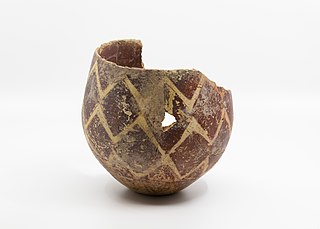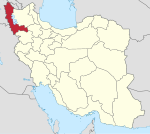Location
Dalma Tepe is located at the southwestern end of Lake Urmia, north of the modern village of Dalma. There are two other small tells close by, including Agrab Tepe. Ḥasanlū Tepe site is about 5 km southwest of Dalma.
Dalma Tepe was inscribed on the national heritage list of Iran in 2006. In 2021, Archaeological survey again began at Dalma Tepe after a six-decade hiatus. [1]
The mound rises approximately 4 meters above the surrounding plain. Its diameter measures approximately 50 meters. The site was researched in 1958 by Charles Burney and additionally in 1961 in collaboration with T. Cuyler Young Jr. as part of the Hasanlu Project of The University Museum of Archaeology and Anthropology of the University of Pennsylvania.
Large quantities of handmade, chaff-tempered pottery were found. [2] This includes 'Dalma plain ware', 'Dalma impressed ware', and 'Dalma red-slipped ware', which was covered with a uniform coat of dark-red paint. There was a variety of shapes.
'Dalma painted ware' is decorated with large patterns of triangles in deep shades on red.
Conical clay spindle whorls were also found.
Dalma pottery represents Period IX at Ḥasanlū Tepe, and is dated to around 5000–4500 BCE. Links with Level XVI at Tepe Gawra have been identified, which, in northern Iraq, represents Ubaid 3 period. [3]
Similar pottery has been found at Seh Gābī and Godin Tepe, attributed to Period X. Kul Tepe Jolfa is another related site from the same period. It is located north of Lake Urmia. [4]
In 2013, nine ancient sites containing Dalma sherds have been identified in the Songhor and Koliyaei Plains in Central Zagros. [5]

The Kura–Araxes culture was an archaeological culture that existed from about 4000 BC until about 2000 BC, which has traditionally been regarded as the date of its end; in some locations it may have disappeared as early as 2600 or 2700 BC. The earliest evidence for this culture is found on the Ararat plain; it spread north in the Caucasus by 3000 BC.

Teppe Hasanlu or Hasanlu Tepe is an archeological site of an ancient city located in northwest Iran, a short distance south of Lake Urmia. The nature of its destruction at the end of the 9th century BC essentially froze one layer of the city in time, providing researchers with extremely well preserved buildings, artifacts, and skeletal remains from the victims and enemy combatants of the attack. The site was likely associated with the Mannaeans.

Shahr-e Sukhteh, c. 3550–2300 BC, also spelled as Shahr-e Sūkhté and Shahr-i Sōkhta, is an archaeological site of a sizable Bronze Age urban settlement, associated with the Helmand culture. It is located in Sistan and Baluchistan Province, the southeastern part of Iran, on the bank of the Helmand River, near the Zahedan-Zabol road. It was placed on the UNESCO World Heritage List in June 2014.
Tepe Sialk is a large ancient archeological site in a suburb of the city of Kashan, Isfahan Province, in central Iran, close to Fin Garden. The culture that inhabited this area has been linked to the Zayandeh River Culture.

Godin Tepe is an archaeological site in western Iran, located in the valley of Kangavar in Kermanshah Province. Discovered in 1961, the site was excavated from 1965 to 1973 by a Canadian expedition headed by T. Cuyler Young Jr. and sponsored by the Royal Ontario Museum. The importance of the site may have been due to its role as a trading outpost in the early Mesopotamian trade networks.
Hajji Firuz Tepe is an archaeological site located in West Azarbaijan Province in north-western Iran and lies in the north-western part of the Zagros Mountains. The site was excavated between 1958 and 1968 by archaeologists from the University of Pennsylvania Museum of Archaeology and Anthropology. The excavations revealed a Neolithic village that was occupied in the second half of the sixth millennium BC where some of the oldest archaeological evidence of grape-based wine was discovered in the form of organic residue in a pottery jar.
Kültəpə is a settlement dating from the Neolithic Age, a village and municipality in the Babek District of Nakhchivan, Azerbaijan. It has a population of 1,859.
Tureng Tepe is a Neolithic and Chalcolithic archaeological site in northeastern Iran, in the Gorgan plain, approximately 17 km northeast of the town of Gorgan. Nearby is a village of Turang Tappeh.

Cheshmeh-Ali is an ancient recreational place, located in the south of Tehran and north of Rey or Ray in the country of Iran. The spring is spot in the neighborhood of Ebn-e Babooyeh, Tughrul Tower, and below the Rashkan castle and next to Rey Castle and Fath Ali shah inscription.
The Halaf-Ubaid Transitional period or HUT is a prehistoric period of Mesopotamia. It lies chronologically between the Halaf period and the Ubaid period. It is still a complex and rather poorly understood period. At the same time, recent efforts were made to study the gradual change from Halaf style pottery to Ubaid style pottery in various parts of North Mesopotamia.

Bābā Jān Tepe (Tappa), an archeological site in north-eastern Lorestan Province, on the southern edge of the Delfān plain at approximately 10 km from Nūrābād, important primarily for excavations of first-millennium BC levels conducted by C. Goff from 1966-69. Work concentrated on two mounds joined by a saddle. The East Mound yielded a series of first-millennium BC buildings above Bronze Age graves. On the Central Mound, excavation concentrated on the Baba Jan III Manor on the summit; an 8 x 6 m Deep Sounding provides a partial late fourth- to mid-second-millennium BC sequence

Alikomektepe is an ancient settlement located in Jalilabad District (Azerbaijan), in the Mugan plain, belonging to the Chalcolithic period, dating to c. 5000 BC. Early levels belonged to the Shulaveri-Shomu culture. It covers an area of over 1 hectare.

Yarim Tepe is an archaeological site of an early farming settlement that goes back to about 6000 BC. It is located in the Sinjar valley some 7km southwest from the town of Tal Afar in northern Iraq. The site consists of several hills reflecting the development of the Hassuna culture, and then of the Halaf and Ubaid cultures.
Kul Tepe Jolfa is an ancient archaeological site in the Jolfa County of Iran, located in the city of Hadishahr, about 10 km south from the Araxes River.

The Nakhchivan culture, also known as the Kizilveng culture or Painted Pottery culture, was formed during the Middle Bronze Age in the 3rd and 2nd millennium BC. The main center of painted pottery were Nakhchivan and the Arpachay Valley, in Anatolia, Urmia lake basin and the South Caucasus. In Azerbaijan, this culture was studied on the basis of archeological materials from the I Kultepe, II Kultepe, Shahtakhti, Gizilburun, Nahjir, Shortepe, Garachuk, II Gazanchi qala and other monuments. The painted pottery culture was studied by Azerbaijani archaeologists such as O. Habibullayev, V. Bakhshaliyev, V. Aliyev and A. Akbarov. According to V. Bakhshaliyev, the formation of this culture dishes in Nakhchivan was connected with the formation of the city states.
Rose L. Solecki was an American archaeologist, who worked with her husband Ralph Solecki on excavations in Iraq, Iran, Turkey, Syria, Lebanon, and Sudan.

Dalma culture was a prehistoric archaeological culture of north-western Iran dating to early fifth millennium B.C. Later, it spread into the central Zagros region and elsewhere in adjacent areas. Its widespread ceramic remains were excavated in central and northern valleys of the Zagros Mountains in north-western Iran. Dalma assemblages were initially discovered by the excavations carried out at Dalma Tepe and Hasanlu Tepe in south-western parts of Lake Urmia, in the valley of Solduz.
Carol Kramer was an American archaeologist known for conducting ethnoarchaeology research in the Middle East and South Asia. Kramer also advocated for women in anthropology and archaeology, receiving the Squeaky Wheel Award from the Committee on the Status of Women in Anthropology in 1999. Kramer co-wrote Ethnoarchaeology in Action (2001) with Nicolas David, the first comprehensive text on ethnoarchaeology, and received the Award for Excellence in Archaeological Analysis posthumously in 2003.
Tell Madhur is a tell, or archaeological settlement mound, in Diyala Governorate (Iraq). The site was excavated due to it being flooded by the reservoir created by the Hamrin Dam. Madhur is best known for its particularly well-preserved Ubaid house. A significant Early Dynastic occupation, consisting of a rounded building typical for the Hamrin region at the time, has also been attested at Madhur.
Bülövaqaya settlement is an archeological site located on the left bank of the Sarisu river, west of Göynük village of Babek district.











